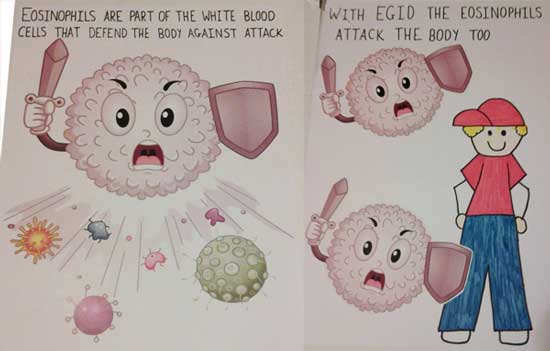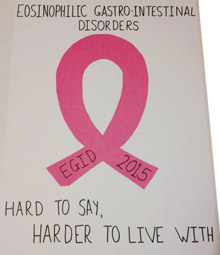|
|
|
Living with Eosinophilic gastric disorders, food allergy – and type 1 diabetes! |
|
After a long and difficult battle to find a medical answer for her son’s constant ill-health, Eosinophilic Colitis (EC) was diagnosed when he was 7 and Rachel’s blog, 7yearstodiagnosis.com, was born.
Rachel explains a bit more about EC and what it is like to live with it. And then you can listen to the amazing video that they all made last year for National Eosinophil Awareness Week. |
Imagine Imagine being told that your child has a chronic illness that neither you, nor most of the medical professionals you’ll end up meeting from that point on, can pronounce – or have even heard of until that moment. Imagine finding out that that illness is rare: that around 1 in 10,000 people are diagnosed with the most common form, but that your child has one of the rarest forms and that there is little research into it. Imagine learning that even the medical community struggles to reach a consensus about this rare disease and whether it really exists or is simply part of a much bigger picture – but nonetheless, having to live with the reality of this rare disease and its effects on your family’s life on a daily basis. (For those who wonder if EGID is real, try living with anyone who is in the midst of an EGID flare up and, bigger picture or not, you'll understand why we will continue to fight for research into this unquestionably chronic and life-impacting illness.) Imagine the heartbreak of holding your sobbing child at 3am, with tears streaming down your own face, as you struggle to find some, any words to bring him a little comfort. Imagine taking one food after another out of his diet in a hope to bring some relief from the chronic pain and poor bowel function, until you are left with the final realisation that perhaps you need to remove everything and feed him via a tube to see if that is the answer you’ve been seeking for the first 9 years of his life. And then imagine starting to put foods back in, one at a time, only to discover that his body has allergic reactions to more than you ever thought possible. This is the reality of the last three years of our life. When, at the age of seven, our son, M, was diagnosed with Eosinophilic Colitis (EC), part of the Eosinophilic Gastro-Intestinal Disorders (EGID) family, at Great Ormond Street Hospital (GOSH), Mike and I had no idea what the impact of this chronic illness would have on our whole family, not just on us and M, but on his big sister too. Since his diagnosis, I have read widely about this complex inflammatory bowel disease and spend much of my time educating those around us as so few people, even in the medical community, know anything about it. We have all become active in raising awareness and I’m proud that both my son and daughter have become as ardent a pair of advocates in promoting awareness as I now am myself. So what is the real story about EGID? 
EGIDS are a complex and chronic group of digestive system disorders caused by an abnormally raised level of eosinophils within the gastro-intestinal tract. Eosinophils are an important type of white blood cell, which normally help the body fight off certain infections and parasites and are typically involved in attacking the causes of allergic reactions, thus protecting the body. But in some individuals, the body produces too many eosinophils in a particular part of the GI tract, which leads to chronic inflammation and can cause extensive tissue damage in the area. Like many inflammatory bowel diseases, EGID is a classic waxing and waning condition, meaning that the symptoms and their severity can change on a daily basis. This family of rare diseases is diagnosed depending on where in the GI tract the elevated eosinophilic count has been found. The most common form is Eosinophilic Oesophagitis (EE or Eoe); M has been diagnosed with Eosinophilic Colitis (EC) where the eosinophils have caused damage to his large intestine or colon. The symptoms of EGID are multiple and varied and not only are they not exclusive to EGID, but neither are they all experienced by all patients which makes diagnosis a long and drawn out process. It was the odd combination of symptoms experienced by M during the first 7 years of his life – chronic diarrhoea, poor bowel function, poor weight gain, joint pains, extreme mood swings, excessive sweating, body odours and allergic 'shiners' – as well as the results of biopsies and scopes that led to his diagnosis. As eosinophils are part of the body’s response to allergic reactions, it comes as no surprise that many people with EGID struggle with food and environmental allergies too. Just as the illness can wax and wane, so too can these allergies and therefore they can change over the years. Initially we were asked to put M on a MEWS-free (Milk, Egg, Wheat, Soya free) diet, which is a common starting point for those with EGID and over the next two years we also had to remove gluten, potatoes, raisins and raspberries in an attempt to alleviate his symptoms. Sadly we never reached a point when M was completely symptom free and so 14 months ago we made the decision to remove all food and feed him on an elemental diet via Nasal-Gastric tube to try and give his body some much-needed gut rest. The ensuing struggle to re-introduce foods back into his diet has dominated the last 12 months of my life and has led us to the position of where we are today: 5 safe foods (rice, chicken, cucumber, apple and pear), 2 safe oils (rapeseed and coconut) and as much sugar as he can consume in any sitting. That, however, is another long story and one for another time. Ed: We are very much hoping that M and G are going to get together and provide us with a regular diary piece (just like Ruth's and Sue's diaries) about what it is like living with EGID and a gluten and dairy allergy. Watch this space! Meanwhile... Do check in to FABED, the charity which supports children with eosinophilic disorders, and Rachel's very active blog, 7YearstoDiagnosis, on which, among many other things, she has just covered Feeding Tube Awareness week. February 2016. If you found this article interesting, you will find more articles on EGIDs here, and reports of research into EGIDs here. |

 Rachel’s twitter bio describes her as a “T1D Mum to an EGID son and a food allergy daughter” as well as a part-time accountant and full-time supporter of FABED. Family life has consisted of 30 years with T1D, her own allergy to the humble spud and 10 years of preparing gluten- and dairy-free foods for her daughter.
Rachel’s twitter bio describes her as a “T1D Mum to an EGID son and a food allergy daughter” as well as a part-time accountant and full-time supporter of FABED. Family life has consisted of 30 years with T1D, her own allergy to the humble spud and 10 years of preparing gluten- and dairy-free foods for her daughter. Three years on, and after a year with a feeding tube, her son is currently only able to eat five safe foods and she considers herself an expert on cooking delicious meals containing little more than chicken, rice, cucumber, apple and pear.
Three years on, and after a year with a feeding tube, her son is currently only able to eat five safe foods and she considers herself an expert on cooking delicious meals containing little more than chicken, rice, cucumber, apple and pear. 










